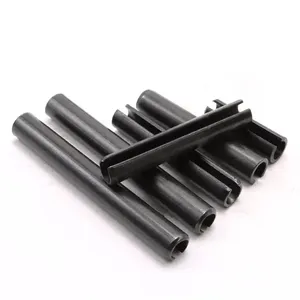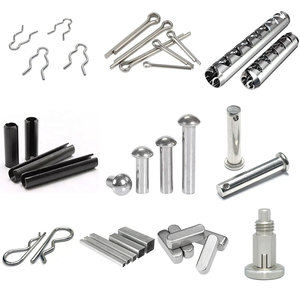
All categories
Featured selections
Trade Assurance
Buyer Central
Help Center
Get the app
Become a supplier

(11120 products available)



















































Quick release pin is deemed necessary when there is need to connect or disconnect components quickly and easily. It consists of a body with a tapered end and a secured head with a long or short collar. The collar offers rotational and linear movement. There are multiple types of pins in the market today, and they include:
Ball Lock Pins
Ball lock cotter pins incorporate retractable balls in their design. The balls create a secure and strong connection when seated into a hole and can easily be released or locked with a simple rotational movement. This makes it ideal for heavy-duty applications. Often used in machinery, aerospace, and automotive industries. The quick release pin can, however, find its way into other less demanding work environments.
Taper Lock Pins
Taper lock pins have a tapered tip that wedges securely into the conned component's tapered socket. These quick release pins are preferred where high strength and precision are required, especially when there are needs to frequently remove and reinstall parts. Commonly found in molds and tooling applications in manufacturing, they help ensure proper orientation and minimal wear.
Double Lock Pins
As the name suggests, double-lock pins have two retractable balls or elements that provide an extra locking mechanism. This pin is considered to add more security to the already secure ball lock pins. These pins are used in applications that require extra safety because of heavy loads or dynamic forces. Common uses include rigging, heavy machinery, and structural engineering where failure is not an option.
Pull Lock Pins
Pull lock pins incorporate a sleeve that must be pulled and then pushed to lock or unlock. Their design allows for quick locking and unlocking with one hand. This makes them ideal for applications that require frequent adjustments. Found in automotive, furniture, and equipment industries.
Locking Snap Pins
Locking snap pins are designed to provide a reliable locking mechanism. They offer secure yet quick access. The snap pins-named include a spring-loaded snap that easily attaches to or detaches from a stud or shaft. Their versatility allows their use in both industrial and light commercial applications. These include machinery and equipment as well as agricultural implements.
The durability of a quick-release pin is very important because it directly impacts the pin's funcionality in relation to the end-use. The materials used in the construction of these pins are chosen according to several factors. These include strength, corrosion resistance, operating environment, and customer satisfaction.
Stainless Steel
Stainless steel is one of the commonly used materials due to its excellent corrosion resistance, tensile strength, and durability. Often used in quick-release pins used in marine, aerospace, automotive, and medical fields. Other less intense applications like agricultural work or health care also use stainless steel since this will increase the useful life of the pin and decrease maintenance.
High-Strength Alloy Steel
Since alloy steel incorporates other elements like chromium and nickel that improve hardness and strength, alloy steel is often used for quick release slow pins that require extreme forces, thus resulting in heavier operations. Rarely will alloy pins be found in light commercial or consumer applications simply because demand for them is not as heavy as other industries. However, when they are used in any of these spaces, they are definitely employed in mining, rigging, or any other heavy manufacturing.
Aluminium
Aluminum pins are lightweight, non-corrosive, and easy to form. This makes them a popular choice in applications where weight matters but the strength required is relatively low. Normally, it will be found within the sporting goods, agriculture, and construction industries, which require frequently employed pins.
Bearing Bronze or Brass
Bronze or brass used quick release pins are highlighted with excellent wear resistance. This makes it suitable for applications where the pin interacts frequently with other metal components. Normally, bronze and brass pins are used in mechanical devices. Also used in marine applications where both durability and anti-corrosive properties are necessary and within engineering sectors that require frequent wear and tear on the pin.
Plastic or Composite Materials
While less common, quick release pins of plastic or composite materials are used in applications where non-magnetic, lightweight, or non-conductive properties are required. Such pins are often found in electronic devices, medical equipment, and environments where corrosion due to chemical exposure is a high risk. These pins come at a relatively low cost, easy to manufacture, and disposability add to their appeal considering that durability is the main goal.
There are several uses of a cotter quick release pin across multiple industries. It helps to increase operational efficiency while also ensuring safety and reliability in the processes. Some common applications include:
Aerospace and Defence
Aerospace and defense industries utilize quick release pins to secure critical components on aircraft and defense systems. Their ability to withstand extreme conditions while allowing for quick access and minimal tools makes them ideal for emergency applications. Commonly applied to detachable or moving parts like access panels, landing gears, and flight control surfaces. The pinned plays a critical role in enhancing operational efficiency and reducing downtime. Therefore, quick release pins are often used in high-end commercial and military applications.
Automotive Industry
In the automative field, quick release pins are used in closing and opening hoods, doors, and tailgates. They find extensive applications in motorsport too because of their quick attachment and detachment, and they are also easy to use. The cotter pin will help reduce the time for vehicle repairs and part replacements and therefore increase productivity on the race tracks or workshops.
Heavy Machinery and Equipment
Quick release pins are standard in agricultural and construction machinery. It is usually applied in the attachment of buckets, forks, and other implements. This makes it easy to switch tools without the use of specialized equipment. It also enables operators to increase efficiency while minimizing the equipment's downtime and labor costs as well.
Marine Applications
Usually, marine applications expose components to corrosion. That's why they often utilize quick release pins made of stainless steel, brass, or bronze. The pins are normally used to secure rigging hardware, sails, and other deck equipment and are designed to withstand harsh marine environments while ensuring easy disassembly. They are critical for safety and maintenance in boating and shipping operations.
Medical Devices
The medical equipment must be disassembled and sanitized and then reassembled without any special tools. Yet, there is no margin of error in this area. That's why quick release pins fit right in, from MRI machines to surgical tools; the pins are the unsung heroes behind the ease of use and durability in this sensitive space.
The correct pin selection depends on several factors, including load, environmental conditions, and ease of use, which are mainly the operational requirements and industry-specific needs. Some of the following guidelines will help make the selection easier:
Load Capacity
The pin selected should generally be able to carry the load within the application. Higher tensile strength materials for heavy loads, quick release pins, are normally required. Less demanding operations do not require heavy-duty pins as they can use lighter ones.
Corrosion Resistance
Normally, quick release pins are made of stainless steel, bronze, or brass for applications prone to corrosion or exposure to harsh elements, such as marine and outdoor uses. Since stainless steel has both corrosion resistance and strength, it is normally used in most marine applications. While bronze has anti-friction properties, it increases wear resistance within the mechanical applications.
Pin Diameter and Length
The diameter and length of the pin should always be compatible with the mating holes or slots within the equipment or structure. Consuming a longer pin, in most cases, will offer more strength, but it is also more difficult to handle because it is larger than necessary. Therefore, the size should be appropriate and secure without freely rotating or wobbling.
Ease of Use
Increased demands for ease of installation will increase the demand for cotter pins with user-friendly designs, particularly for industries where quick changes and minimal tooling are required. The pull lock pins are usually operated with one hand. This makes them preferred in automotive and construction because the changeover can be done quickly.
Type of Application
Different applications normally require different types of pins. For example, due to their strength, taper lock pins are normally applied in manufacturing and tooling, while double lock pins are commonly utilized in rigging and heavy lifting because of their enhanced security. Quick release pins are popular for their versatility in parts that are frequently removed or replaced.
Indeed, quick release pins can be used in outdoor applications, especially if the pins are made of stainless steel, bronze, or brass. These materials offer excellent corrosion resistance, making pins ideal for marine, construction, and agriculture since they are exposed to elements.
Yes, there are quick release pins for heavy loads. They have alloy steel or tapered quick release pins. These pins have high tensile strength and are normally ideal for aerospace, mining, rigging, and heavy machinery operations.
To ensure the correct pin size, the pin diameter and length should be compatible with the mating holes or slots of the equipment. There should not be any size variations that are too big or too small since those will compromise security and safety.
The benefits of using a composite quick release pin are light weight, non-magnetic, and less cost. They are also easy to dispose of. This makes them ideal for electronic devices and applications where quick pins will be exposed to chemical elements.
Yes, quick release pins are commonly used in medical devices. They are used in MRI machines, surgical tools, and equipment. They are easy to disassemble, which is great for sanitization. It is a user-friendly device that fits well in this space of application.